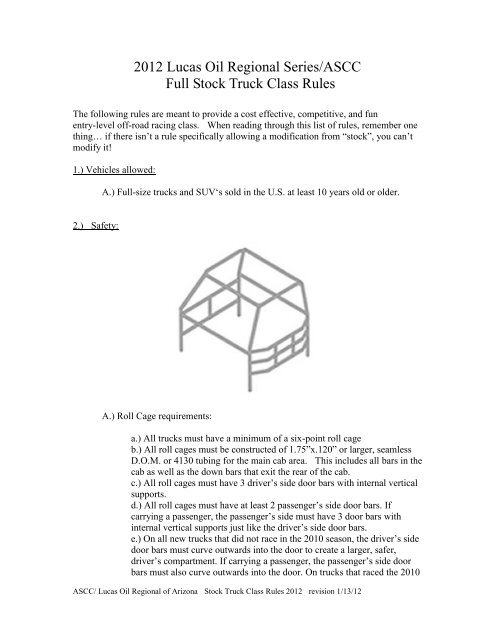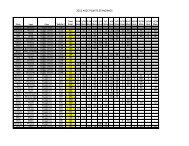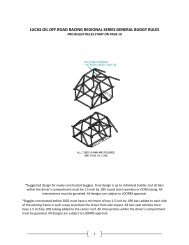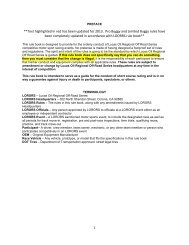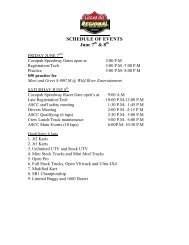2012 Lucas Oil Regional Series/ASCC Full Stock Truck Class Rules
2012 Lucas Oil Regional Series/ASCC Full Stock Truck Class Rules
2012 Lucas Oil Regional Series/ASCC Full Stock Truck Class Rules
You also want an ePaper? Increase the reach of your titles
YUMPU automatically turns print PDFs into web optimized ePapers that Google loves.
<strong>2012</strong> <strong>Lucas</strong> <strong>Oil</strong> <strong>Regional</strong> <strong>Series</strong>/<strong>ASCC</strong><br />
<strong>Full</strong> <strong>Stock</strong> <strong>Truck</strong> <strong>Class</strong> <strong>Rules</strong><br />
The following rules are meant to provide a cost effective, competitive, and fun<br />
entry-level off-road racing class. When reading through this list of rules, remember one<br />
thing… if there isn’t a rule specifically allowing a modification from “stock”, you can’t<br />
modify it!<br />
1.) Vehicles allowed:<br />
A.) <strong>Full</strong>-size trucks and SUV‘s sold in the U.S. at least 10 years old or older.<br />
2.) Safety:<br />
A.) Roll Cage requirements:<br />
a.) All trucks must have a minimum of a six-point roll cage<br />
b.) All roll cages must be constructed of 1.75”x.120” or larger, seamless<br />
D.O.M. or 4130 tubing for the main cab area. This includes all bars in the<br />
cab as well as the down bars that exit the rear of the cab.<br />
c.) All roll cages must have 3 driver’s side door bars with internal vertical<br />
supports.<br />
d.) All roll cages must have at least 2 passenger’s side door bars. If<br />
carrying a passenger, the passenger’s side must have 3 door bars with<br />
internal vertical supports just like the driver’s side door bars.<br />
e.) On all new trucks that did not race in the 2010 season, the driver’s side<br />
door bars must curve outwards into the door to create a larger, safer,<br />
driver’s compartment. If carrying a passenger, the passenger’s side door<br />
bars must also curve outwards into the door. On trucks that raced the 2010<br />
<strong>ASCC</strong>/ <strong>Lucas</strong> <strong>Oil</strong> <strong>Regional</strong> of Arizona <strong>Stock</strong> <strong>Truck</strong> <strong>Class</strong> <strong>Rules</strong> <strong>2012</strong> revision 1/13/12
season, flat door bars will be allowed so long as there are no openings<br />
larger than 144 square inches and all tubing junctions have a proper<br />
gusset. If your truck build was started during the 2010 season contact a<br />
series official and ask to be grandfathered in under the same rules as<br />
trucks that participated during the 2010 season. There is no guarantee<br />
that you will be grandfathered in, and only those builds that series officials<br />
were previously aware of will be allowed this courtesy.<br />
f.) All roll cages must be constructed with diagonal supports to keep the<br />
cage from collapsing in a sideways, top-to-bottom, or front-to-rear<br />
impact.<br />
g.) All structural intersections of tubing must have a 3”x3”-.120” thick<br />
plate style or at least a 1“x.065” wall thickness tubing gusset.<br />
h.) Additional tubing beyond the minimum requirements may be added<br />
and doesn’t have to be 1.75“x.120”.<br />
B.) <strong>Oil</strong> System requirements:<br />
a.) All trucks with an electric fuel pump must have power to the fuel pump<br />
routed through an AC Delco low-oil-pressure switch (AC DELCO<br />
# 25036938) to cut off power to the fuel pump in the event the<br />
engine stops.<br />
b.) Any oil coolers, if used, must be located outside the cab area. There<br />
must be a firewall of at least .040” thick metal between the driver<br />
and cooler.<br />
c.) No oil lines allowed inside the cab.<br />
C.) Fuel System requirements:<br />
a.) All trucks must use a commercially produced fuel cell located in the<br />
center of the bed.<br />
b.) Fuel cell must have a bladder encased in a metal housing. The metal<br />
housing can be steel or aluminum, and must be at least 16ga. thick.<br />
c.) The fuel cell must be located in the middle of the bed area, and must be<br />
mounted with at least 1” wide x .125” thick flat steel bar stock.<br />
d.) Must have a minimum of 3 straps holding the cell in the truck, at least<br />
2 straps side to side, and at least 1 strap lengthwise.<br />
e.) The fuel cell vent must be routed in such a manner to keep fuel from<br />
escaping in event of a roll-over.<br />
<strong>ASCC</strong>/ <strong>Lucas</strong> <strong>Oil</strong> <strong>Regional</strong> of Arizona <strong>Stock</strong> <strong>Truck</strong> <strong>Class</strong> <strong>Rules</strong> <strong>2012</strong> revision 1/13/12
f.) All fuel lines must be routed away from any moving objects, and the<br />
exhaust.<br />
g.) If the fuel cell is mounted within reach of the driveshaft, a protective<br />
shield must be mounted between the cell and driveshaft.<br />
h.) All mounting hardware for the fuel cell and shield must be a minimum<br />
of 3/8” diameter and Grade 8 or better.<br />
D.) Driver’s safety equipment:<br />
a.) A one piece driver’s suit is required. The suit must cover from the neck<br />
to ankles, and to the wrists. All suits must have the SFI label attached, and<br />
meet SFI spec 3-2A/5 or higher. All safety equipment must be clean, in<br />
good condition, and free from any rips or worn areas.<br />
b.) Driver must wear gloves and shoes that meet SFI spec 3.3/5 or higher.<br />
c.) <strong>Full</strong> faced helmets with face shield are mandatory. Helmet must be<br />
certified to one or more of the following: Snell Memorial Foundation SA<br />
2005 or better with a legible SNELL sticker attached, SFI spec 31.1/5 or<br />
better with SFI sticker attached, or FIA 8868 with a legible FIA sticker<br />
attached.<br />
d.) Lexan shield must be closed during competition.<br />
e.) 5 or 6-point seatbelt harness that meets SFI spec 16.1 or 16.5 is<br />
required.<br />
f.) Sternum straps are not allowed.<br />
g.) Head and Neck restraints are required. D-Cell, R3, and Hybrid are the<br />
only devices currently approved.<br />
h.) Only manufactured racing seats are permitted.<br />
i.) Window nets are required next to any occupants. Nets must meet SFI<br />
spec 27.1 and have SFI label attached. Ribbon or honeycomb mesh are<br />
approved. The window net should cover the entire window opening to<br />
allow no more than 3” for access to occupant. The safety net anchor must<br />
be welded to the cage. The window latch must be located at the top front<br />
end of the net. Latch must be a safety belt style latch.<br />
j.) A windshield screen is recommended to protect driver. The maximum<br />
opening size in this screen is 1.5”x1.5”, and the minimum material<br />
thickness is .125”.<br />
<strong>ASCC</strong>/ <strong>Lucas</strong> <strong>Oil</strong> <strong>Regional</strong> of Arizona <strong>Stock</strong> <strong>Truck</strong> <strong>Class</strong> <strong>Rules</strong> <strong>2012</strong> revision 1/13/12
3. Chassis:<br />
E. Firewall:<br />
A.) Frame:<br />
B.) Body:<br />
a.) Complete front and rear OEM firewalls are required.<br />
b.) All open holes in the firewalls must be filled so that no more than 3/8”<br />
openings exist.<br />
c.) On trucks or S.U.V.’s that don’t have an OEM rear firewall, a firewall<br />
must be fabricated from steel or aluminum of at least .040” thickness.<br />
This firewall must extend from the driver’s shoulders down to the bottom<br />
of the cab, and from side to side of the cab.<br />
a.) Complete un-altered OEM frame must be used. No material may be<br />
removed with the exception of any un-used brackets or tabs.<br />
b.) Material may be added to reinforce the frame.<br />
c.) No material may be removed from any cross member except for<br />
required driveshaft or rear end clearance.<br />
d.) Radiator may be relocated to the rear of the cab, but must have a<br />
firewall between the driver and radiator. If the radiator is positioned<br />
above the rear firewall, a protective screen must be installed to<br />
protect the radiator from puncture on the front side. At no time can<br />
any portion of the radiator be outside the main roll cage structure.<br />
a.) OEM cab must be used. No external modifications allowed except for<br />
roll-cage tubing clearance.<br />
b.) Internal sheet metal may only be trimmed for roll cage clearance.<br />
c.) Any un-used tabs or brackets may be removed to provide a safer<br />
driver’s compartment.<br />
d.) OEM looking grill is recommended.<br />
e.) All glass and removable trim must be removed.<br />
f.) All headlights and side markers must be removed. Headlight openings<br />
must be covered.<br />
g.) Doors must be welded or bolted shut.<br />
h.) Fenders must be securely bolted on. No Dzus fasteners allowed.<br />
i.) Body must be mounted within 1” of factory location.<br />
j.) <strong>Stock</strong> rubber body mounts may be removed or replaced with other<br />
material.<br />
k.) Removal of front and rear inner fenders is allowed.<br />
l.) Up to 2” of fender well opening may be removed and fenders may be<br />
flared out an additional 2” to allow for tire clearance.<br />
m.) Dash may be removed. Aftermarket analog and electrical individual<br />
gauges are allowed. Electronic dashes are not allowed.<br />
<strong>ASCC</strong>/ <strong>Lucas</strong> <strong>Oil</strong> <strong>Regional</strong> of Arizona <strong>Stock</strong> <strong>Truck</strong> <strong>Class</strong> <strong>Rules</strong> <strong>2012</strong> revision 1/13/12
C.) Electrical:<br />
n.) Removal of the inner fenders and floor of bed is allowed.<br />
a.) Battery may be relocated, but must not be located inside cab.<br />
b.) A master shut off switch is required. It must be located on<br />
dash panel within reach of officials through the driver’s side window.<br />
c.) A working stock OEM alternator for the make and model of truck is<br />
required. Must be mounted in stock location.<br />
d.) A momentary switch is allowed for priming fuel system while engine<br />
is not running.<br />
D.) Drivetrain:<br />
a.) No aluminum heads of any type are allowed. Only OEM cast iron<br />
heads are allowed. No aftermarket heads are allowed, including<br />
Ford Racing, Mopar, and GM Performance Parts.<br />
b.) The engine block must be an OEM production cast iron block.<br />
Aftermarket blocks are not allowed, including Ford Racing,<br />
Mopar, and GM Performance Parts blocks.<br />
c.) No fuel injection, turbo, supercharger, or nitrous systems are allowed.<br />
All engines must remain naturally aspirated with a carburetor.<br />
d.) Driveshaft must be painted white and have vehicle number on it.<br />
Driveshaft must also have a retaining loop within12 inches of the<br />
front and u-joint. If a center u-joint is required, a driveshaft loop is<br />
required within 12 inches of it on the rear most portion of the<br />
driveshaft as well as another loop within 12 inches of the front u-<br />
joint.<br />
e.) Maximum engine size is 360 cubic inches. Displacement formula used<br />
for tech purposes is = (Bore/2) x (Bore/2) x (3.14159) x (Stroke) x (# of<br />
cylinders). All measurements are made in inches and rounded to 3 decimal<br />
points.<br />
f.) Commercially available aftermarket cast intake manifolds are allowed.<br />
No external modifications allowed on intake manifold. No fabricated<br />
intake manifolds allowed.<br />
g.) Any fuel pump and fuel pressure regulator may be used.<br />
h.) Aftermarket carburetors are allowed. Maximum 1 carburetor.<br />
i.) Any air cleaner may be used.<br />
j.) Any header may be used.<br />
k.) At certain tracks, these trucks must have a working muffler(s). If<br />
mufflers are required by a track, all exhaust must pass through the<br />
muffler(s). It is up to each individual track to allow or not allow open<br />
exhaust systems on these trucks. Please contact a series official prior to<br />
each event to verify the need to run mufflers.<br />
<strong>ASCC</strong>/ <strong>Lucas</strong> <strong>Oil</strong> <strong>Regional</strong> of Arizona <strong>Stock</strong> <strong>Truck</strong> <strong>Class</strong> <strong>Rules</strong> <strong>2012</strong> revision 1/13/12
l.) A performance clutch may be used to increase durability.<br />
m.) A ¼” thick steel bell housing shield is required on manual<br />
transmission trucks. The shield must cover the top 270 degrees of<br />
the bellhousing. On automatic transmission trucks, a transmission<br />
shield or blanket must cover the top 270 degrees of the main casing.<br />
n.) No race fuel is allowed. Only 91octane pump gas is allowed.<br />
o.) A spool, limited slip, or locker is allowed.<br />
p.) Ring and Pinion gear ratio is open.<br />
q.) Gusseting or strengthening of the rear-end housing is allowed.<br />
E. Bumpers & Nerf bars<br />
a.) Front bumper must have looped ends. Front bumper may not extend<br />
more than 12” in front of the hood.<br />
b.) Rear bumper must be built in a manner to protect the fuel cell from<br />
impact.<br />
c.) Bumpers must not protrude past the outside of tires when viewed from<br />
the front or rear.<br />
d.) Nerf bars are allowed, but may not extend more than 2” wider<br />
than the widest portion of the body. The front and rear<br />
ends of the nerf bars must be looped inwards. Nerf bars must<br />
attach to frame.<br />
F. Minimum Weight:<br />
a.) 4 wheel drive trucks must weigh at least 4200lbs. including driver.<br />
b.) 2 wheel drive trucks must weigh at least 3700lbs. including driver.<br />
c.) Minimum weights are measured with driver as they come off the track.<br />
d.) Minimum weights may also be checked before going onto the track.<br />
G.) Tires and Wheels:<br />
a.) Tires must be D.O.T. and available to the general public through<br />
normal dealer distribution.<br />
b.) Maximum Diameter is 33”.<br />
c.) No beadlock wheels.<br />
d.) No inner liners allowed.<br />
e.) Wheels must be in good repair. Both steel and aluminum are allowed.<br />
f.) No wheel covers are allowed.<br />
H.) Suspension:<br />
a.) Front wheel travel is limited to 12 inches. Front wheel travel is<br />
measured on a vertical plane at the center of the spindle. Travel is checked<br />
with the spring and wheel/tire removed. With the frame supported, the<br />
suspension is allowed to droop out. A measurement is taken from the<br />
<strong>ASCC</strong>/ <strong>Lucas</strong> <strong>Oil</strong> <strong>Regional</strong> of Arizona <strong>Stock</strong> <strong>Truck</strong> <strong>Class</strong> <strong>Rules</strong> <strong>2012</strong> revision 1/13/12
ground to the center of the spindle (measurement B). Then compress the<br />
suspension fully and take a measurement from the ground to the center of<br />
the spindle (measurement A). Make sure that there are no bumpstops<br />
installed when checking wheel travel. The wheel travel amount is<br />
“Measurement A” - “Measurement B”.<br />
b.) Rear wheel travel is limited to 12 inches. Rear wheel travel is<br />
measured by supporting the frame and allowing both rear wheels to droop<br />
completely. The measurement from top of the axle housing to the bottom<br />
of the frame is your rear wheel travel. Make sure that there are no<br />
bumpstops installed when checking wheel travel.<br />
c.) All suspension components must remain stock, in stock locations, and<br />
the original mounting methods must be maintained except as noted<br />
elsewhere in this rulebook. Suspension pieces may be reinforced.<br />
d.) Upper and lower shock mounts may be re-located.<br />
e.) Front lower shock mounts must mount directly to an A-arm, I-beam, or<br />
radius arm. No linkages or rocker assemblies allowed between<br />
suspension member and shock.<br />
f.) Suspension components may be strengthened or gusseted as required.<br />
g.) Rear lower shock mounts may be re-located but must remain on the<br />
rear-end housing or leaf spring pad.<br />
h.) The front and rear springs must be of the original concept. I.E. coil<br />
spring, leaf spring, or torsion bar… The front springs or torsion bar may<br />
be relocated to allow ride height adjustment, or to allow the use of<br />
commercially available springs or torsion bars. Rear leaf spring front<br />
perches must remain in OEM location.<br />
i.) Aftermarket springs can be used.<br />
j.) Maximum track width is 70“ as measured from hub face to hub face.<br />
k.) No more than 3 2” shocks can be used per wheel. Maximum of 1 2.5”<br />
diameter shock per wheel. Reservoirs are allowed. Externally adjustable<br />
shocks are not allowed. Bypass shocks, internal or external are not<br />
allowed. Shock length is open.<br />
l.) Rubber or polyurethane bump/droop stops are allowed. No hydraulic<br />
or air “can” style bump stops allowed.<br />
m.) Secondary suspension systems are not allowed.<br />
n.) Limit straps are allowed.<br />
o.) Bushings may be replaced, but must remain rubber or polyurethane.<br />
p.) 2 single point Anti- wrap up bars are allowed. These bars must be<br />
mounted parallel to the frame. They may only connect to the rear end<br />
housing at one point each.<br />
q.) Drum brakes can be converted to disc brakes using factory components<br />
only.<br />
r.) A-arm trucks may replace the upper A-arm with aftermarket A-arm, but<br />
the replacement A-arm must mount in OEM location.<br />
s.) A-arm trucks may replace the upper balljoint with a uni-ball or<br />
aftermarket balljoint.<br />
<strong>ASCC</strong>/ <strong>Lucas</strong> <strong>Oil</strong> <strong>Regional</strong> of Arizona <strong>Stock</strong> <strong>Truck</strong> <strong>Class</strong> <strong>Rules</strong> <strong>2012</strong> revision 1/13/12
I.) Steering:<br />
t.) Aftermarket or custom shackles are allowed on all leaf springs.<br />
Shackle mount location and mounting method is also open.<br />
a.) All steering components must remain OEM stock for year and model<br />
of truck.<br />
b.) The tie-rod sleeves may be replaced with a threaded tube of OEM<br />
length.<br />
c.) Steering quickeners are allowed.<br />
d.) Steering shaft that leads to steering wheel must have at least 2<br />
flexible joints in it.<br />
e.) Any steering wheel may be used.<br />
f.) The tie rod ends may be replaced with heim joints.<br />
<strong>ASCC</strong>/ <strong>Lucas</strong> <strong>Oil</strong> <strong>Regional</strong> of Arizona <strong>Stock</strong> <strong>Truck</strong> <strong>Class</strong> <strong>Rules</strong> <strong>2012</strong> revision 1/13/12


